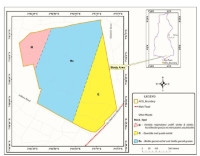ASSESSING EARTHING SYSTEM THROUGH GEOELECTRICAL INVESTIGATION OF SOIL RESISTIVITY ON A SITE IN OYO TOWN, OYO, NIGERIA.
Keywords:
Vertical Electrical Sounding, Geoelectrical Survey, Soil resistivity, EarthingAbstract
The absence of an effective earthing system can lead to the exposure of electrical power systems to high-magnitude transient currents and voltages with rapid rise times, posing risks of equipment damage and harm to individuals. Soil resistance plays a crucial role in the design of an earthing system. Geophysicists commonly employ the electrical resistivity method, a widely used geophysical technique, to assess subsurface properties and identify suitable locations for earthing installations. This method utilizes principles of electrical conductivity and resistivity to characterize the subsurface. This study focuses on the application of the Geo-Electrical resistivity
survey technique to investigate soil conditions and determine earthing properties within Ajayi Crowther University in Oyo State, Nigeria. Ten Vertical Electrical Soundings (VES) were conducted using the Schlumberger Configuration. The VES data were interpreted using the partial curve matching method. The findings revealed the presence of about four unique geo-electric sequences in the surveyed area, namely the topsoil, weathered layer, laterite layer, and bedrock. The thickness of the topsoil layer was found to vary between approximately 0.5 m and 2.9 m. Among the VES measurements conducted, VES 4 and VES 5 exhibited the KH curve type, while
VES 9 displayed the QH curve type. Based on the survey results, VES 9 was identified as the most suitable site for an earthing system due to its lowest resistivity value (< 15 ohms-meter). However, further research is recommended to investigate VES 4 for potential alternative locations. Although VES 4 did not exhibit the lowest resistivity value among the surveyed VES points, it may still hold significant potential for earthing system placement.
Downloads
References
Griffiths, H. and Pilling, N. 2004. Earthing. Advances in high voltage engineering, Hakodate Japan, pp 349-413
Majid Abdulmajeed Salih 2012. Earthing System. pp 14-16. Accessed from https://www.coursehero. com/file/ 63330366/Earthing-Systempdf/ in April 2022.
Loke, M.H. 2000. Electrical Imaging Surveys for Environmental and Engineering Studies. A Practical Guide to 2- D and 3-D Surveys, 61.
Herman, Rhett 2001. An introduction to electrical resistivity in geophysics. American Journal of Physics 69(9), 943-952.
Orellana, E. and Mooney, H. M., 1966. Master tables and curves for vertical electrical soundings over layered structures. Interciencia, Madrid.
Dawalibi, F. P., J. Ma, J. and R.D. Southey, R. D. 1994. The behaviour of Grounding Systems in Multilayer Soils: A parametric analysis. IEEE Transactions on Power Delivery. Vol: 9(1), pp 334-341.
Adegboyega, G. A. and Odeyemi, K. O. 2011. Assessment of Soil Resistivity on Grounding of Electrical Systems: A Case Study of North-East Zone, Nigeria. Journal of Academic and Applied Studies Vol. 1(3) , pp. 28-38
Wightman, W. E., Jalinoos, F., Sirles, P., and Hanna, K. 2003. "Application of Geophysical Methods to Highway Related Problems." Federal Highway Administration, Central Federal Lands Highway Division, Lakewood, CO, Publication No. FHWA-IF-04-021.
Telford, W.M., Geldart, L.P. and Sheriff R.E. 1991. Applied Geophysics. Cambridge University Press, USA, 860p.
Kearey, P., and Brooks, M. 1991. An introduction to geophysical exploration. Wiley, Hoboken.
Markiewicz, H. and Klajn, A. 2003. Earthing Systems - Fundamentals of Calculation and Design. Earthing and EMC Power Quality Application Guide, Wroclaw University of Technology.
Dobrin, M.B. and Savit, C.H. 1988. Introduction to Geophysical Prospecting. 4th Edition, McGraw-Hill, New York, pp 755-771.
Oluwadare, Oluwadare, Amalu and Adebayo J. of NAMP
Gbadegesin, A. and Akinbola, G. E., 1995. Reference Soil of the Southern Guinea Savanna of South Western Nigeria (Oyo State). Nigeria. University of Ibadan and International Soil Reference and Information Centre (ISRIC), Wageningen, The Netherlands. VI, 13p
Akanbi, O. A and Olukowade, O. J., 2017. Lithologic characterisation of the basement aquifers of Awe and Akinmorin areas, southwestern Nigeria. Global Journal of Geological Sciences. Vol 16: 1-11.
Sharma, P. V. 1997. Environmental and Engineering Geophysics. Cambridge University Press. Cambridge. U.K. 474p.
Environmental Protection Agency 1993. Summary information on remote sensing and surface geophysical methods. In: Boulding JR (ed) Use of airborne, surface, and borehole geophysical techniques at contaminated sites, a reference guide. Eastern Research Group, Center for Environmental Research Information, Cincinnati, Ohio (EPA 625/R-92/007).
Paranis, D.S. 1986. Principles of Applied Geophysics. 4th Edition, Chapman and Hall, New York, London.
Keller, G.V., 1966. Dipole method for deep resistivity studies. Geophysics, 31(6): 1088-1104.
Vander Velper, B.P.A., 1988. Resist version 1.0 M.Sc Research project, ITC, Delft, Netherlands.

Downloads
Published
Issue
Section
License
Copyright (c) 2023 The Journals of the Nigerian Association of Mathematical Physics

This work is licensed under a Creative Commons Attribution-NonCommercial-ShareAlike 4.0 International License.




